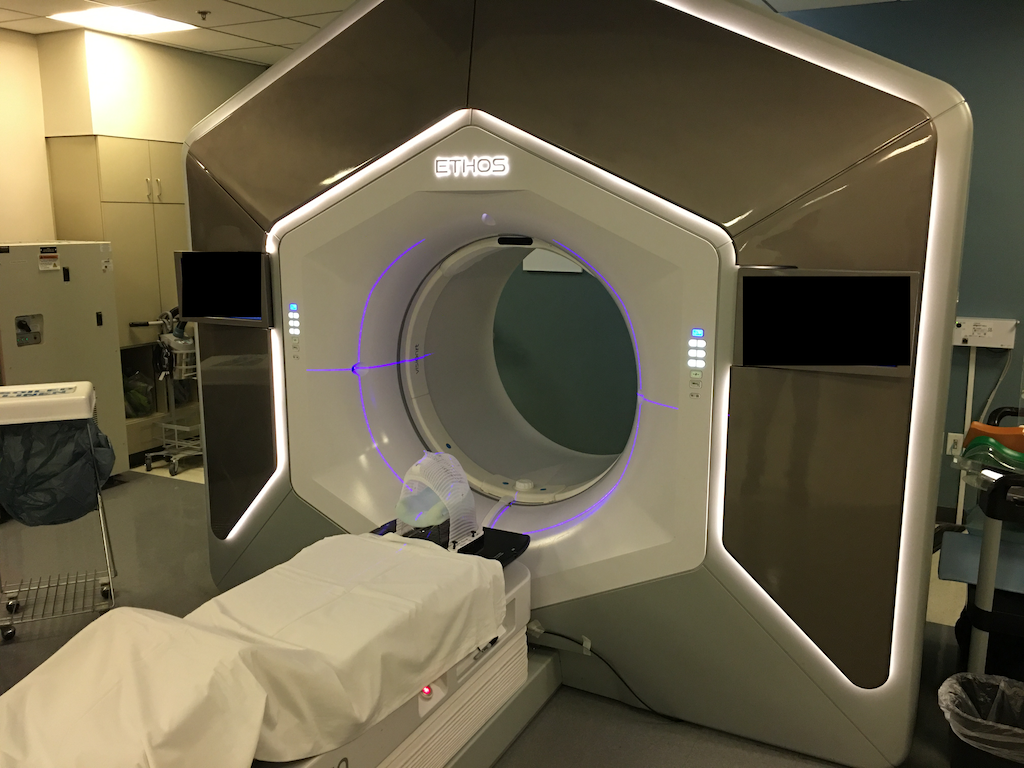Chemoradiotherapy
On June 8 my brain was irradiated with megavoltage X-rays for the last time — ever. I had mixed feelings about this. On the one hand, I was glad to be done with this phase of treatment. Just over two months previously I'd been diagnosed with glioblastoma, a terminal, incurable, and highly aggressive form of brain cancer. A surgery had removed all of the MRI-visible tumor, and then some. Even so, glioblastoma is so invasive that regardless of how much of it gets cuts out, there's always plenty left to kick-start the next round. The return of the demon that had just been surgically exorcised was not a question of "if," but "when."
The end of chemoradiotherapy marked the last of the low-hanging therapeutic fruit. Whatever treatment I pursued from this point on would be less effective and more risky than what I'd done. Even so, I doubted that the chemotherapeutic I'd been given, Temodar, did much good. My tumor lacked the genetic marker present in tumors that respond to the drug.
Even if it was largely a placebo, at least Temodar had few palpable side effects. I understand some patients aren't as lucky, reporting nausea and/or vomiting. These never once affected me. If anything, I had to watch what I ate because my appetite was enormous. But more more about that later. The instructions I was given worked well enough. I ate nothing for at least three hours before bed. One hour before bed, I took an anti-emetic (ondansetron). Then 30-60 minutes later I took the Temodar tablets.
The radiotherapy procedure itself was surprisingly uneventful. The most complicated part was the initial setup, which the staff called "simulation." In this session, held in mid-April, a CT scan was administered. One reason was to check the alignment of the radiation beam, using my last MRI as a map. Another reason was to ensure my comfort during the upcoming treatment runs. Apparently, claustrophoia is a possible problem as the procedure is a bit more constraining than MRI. Still another reason was to fabricate the thermoplastic restraining mask I'd wear during each treatment session.
Radiation treatment would become routine. It would start with being led through an eight-inch thick lead door into the treatment room. The setup was similar to an MRI, with a sliding bed and a tube. However, the tube was much shallower. I'd lie down on the bed, face up. After some adjustments involving the use of a red laser, I'd be ready to go. The thermoplastic stabilizing mask would then be lowered over my face, and some last adjustments made. Finally, the mask would be clamped down tightly enough that I could feel the pulse in my face. Breathing was never a problem, but I could imagine how this procedure would freak some people out.
The table, with me on it locked and loaded, was then slid into the tube. After about 90 seconds, I was taken out.

Music was always played during therapy, but there were some technical glitches getting my preference to work. I ended up just going with whatever the last guy had. This turned out most of the time to be old country western and golden oldies. Oh well I'm the type of guy who will never settle down…
My hair loss started to become noticeable about ten sessions into treatment. The first sign was locks of hair lying on my pillow when I woke up, and mysteriously appearing around the house. Eventually, my hair started coming out in the shower. This was when I pulled the trigger on shaving it all off.
My symptoms progressed noticeably during my 30 radiation sessions. In the days before treatment, placement of my left leg had become imprecise. By the midpoint my balance had become so bad that I started using a walker again. Regressing like this was tough, especially given how hard I'd worked to regain the abilities I'd lost. Drs. Neuro-Oncologist and Radiation-Oncologist assured me this was all part of the process. By the end of treatment I was no longer using a walker.
My overall physical condition, despite some setbacks, remained good throughout treatment. I'd made a promise to myself: if at any point I could not get onto and off of the treatment table under my own power, I'd end treatment on the spot. This included getting myself to and from treatments using public transportation. My reasoning was that if treatment resulted in so much brain damage that I couldn't do this simple thing anymore, it wasn't worth continuing.
It never did come to that, but the ebb-and-flow of stamina and disabilities during chemoradiation would take a heavy toll.